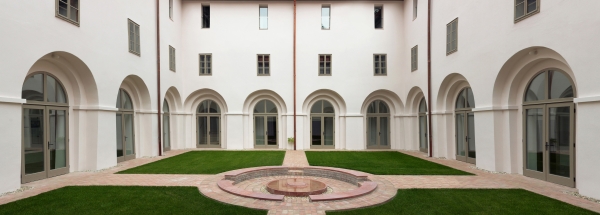A Monastery on the Frontier
Sopronbánfalva, the Reconstruction of the Monastery
Architect: Éva Magyari, Béla Pazár
Text: Miklós Sulyok
Photos: Dániel Zafr – GlobalPress, György Szegő, MNDP Építőművészeti Kft.

The salvation project of this old building could not probably have been managed by more professional experts than the architects’ office of Béla Pazár and Éva Magyari as they had already designed the reconstruction of highly significant historic buildings such as Sándor Palace and the Music Academy in Budapest. However, this project is the joint work of the client and the designer, just like every successful architectural work, with the client now being Gábor Kovács, the famous businessman and art collector, the initiator of KOGART Foundation. The Province of the Hungarian Discalced Carmelites is said to have offered this real estate of significant value as a protected historic monument for sale to him and he has actually purchased it with a good head for business. The goal is a generous and noble one: the building is to house now a centre for meditation and education. Operating in Western Europe for over decades now, this kind of institution of spiritual relaxation has been more and more popular in Hungary recently. The Catholic church and especially the minor monastic orders, such as the Carmelites, are unable to maintain and operate every historic real estate of their own in line with their original functions, and thus a niche opens for investors powerful both materially and spiritually as this kind of investment is not only a financial, but also a spiritual one.
The very first building here was built in the late-15th century but the actual Paulite monastery dates from the 17th century. At the end of the 19th century it was taken over by Carmelite nuns and functioned as a psychiatry and social home from 1950 on till the change of the political system respectfully serving the sick and enduring repeated architectural indignities.
Architects set to work with a concept clear on the whole and in details. The work now realized speaks of their unambiguous and calm approach to the house. There is no trace of architectural uncertainty: the whole structure is filtered through by integrity and systematicness. Their intervention radiates self-confident calmness in the best sense of the word. They knew that this site is a sacred one. It had been in possession of a community the members of which devoted their lives to God. The building had been erected to function as the venue of their communal life and it had been used in this spirit. The task was to reconstruct the whole as it had been but within the limits of common sense. As for the details: to let time breathe in its stones. This is the architectural situation in which even the tiniest details are significant as every intervention and gesture could obliterate the work of centuries without any trace, but what is even more important: they could preserve them for centuries to come. Designers seem to have deep affection for the character of the house chiselled by time. Rooms were created from the former cells of the monks so that the bathrooms had practically been sunk into the width of the walls and thus there was no need to cut into the existing sections of the vaulting. Made of limestone from Solnhofen, the floor covering of the ambulatory has been preserved: actually it is the most beautiful version with manually chipped borders which frequently appears in Hungarian ecclesiastic architecture (e.g. in the ambulatory of the Benedictine arch-abbey in Pannonhalma). When complementing the Baroque staircase block stone was carefully selected for the steps and elsewhere the stones of the thresholds were also treated in a similar way. It seems to be an insignificant but characteristic triviality that the chasuble wardrobe has been preserved: through this nuns living in the enclosure gave the priests serving in the church their cleaned and ironed vestments. A large number of such tiny details make it possible for the aura of the house to flow unhindered once again.
Is there anything less appreciated by contemporary culture, the world of cell phones and community sites than the undisturbed solitude of being on our own? Mass culture enforces upon us a type of human being in constant – online – contact with endlessly flowing floods of information that never leave us alone. So what exactly happened in Sopronbánfalva? The client and the architects co-operating with him saved the environment where solitude may evolve. It does not matter that it would probably serve the relaxation of prospering companies of super-luxurious standards. The sacred character of the location – the prayers and emanation of the souls once living here – is palpable in the interiors. Béla Pazár and Éva Magyari have done the most an architect could do: letting this spiritual factor make its influence felt.
Solitude these days has been pushed back into the sphere of religious spiritual practices. Spiritual trainings are organized by companies and for purposes of psychotherapy. Thus it is now in possession of the sick and the élite. The monastery today bears the name „a centre of education and meditation”. I wish that the spirit of the locality should start speaking in the soul of every human being coming here for a rest.
Design: MNDP Építőművészeti Kft.
Architects: Éva Magyari, Béla Pazár, György Polyák, Tibor Bodnár, Gergő Demjén – MNDP Kft.
Structure: Zoltán Bencze, Krisztián Kecskés, Attila Borbély – CÉH Zrt.
Installations: István Szabó, Balázs Varga – Kovács Pál és Társa Kft.
Electrical engineering: Gábor Biró – BíróBau Bt.
Moisture protection: Sándor Horváth, Csaba Czégeni – Pataky és Horváth Építésziroda Kft.
Public utilities, roads: Éva Kálmán, Péter Horváth – HKÉ Mérnöki Iroda
Kitchen technology: Pál Tamás Aczél – Gastroplan kft.
Art historians: Ferenc Dávid, Tamás Balázsik
Client: NISTEMA Kft.







